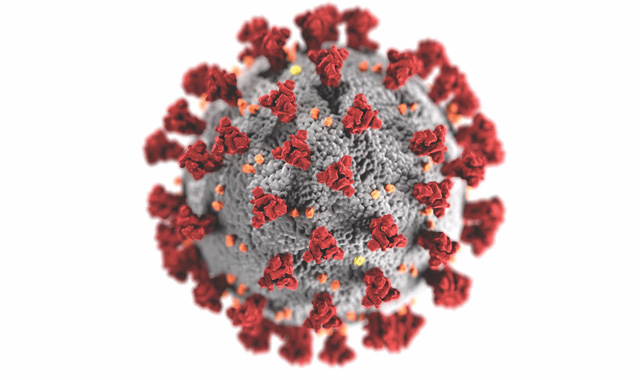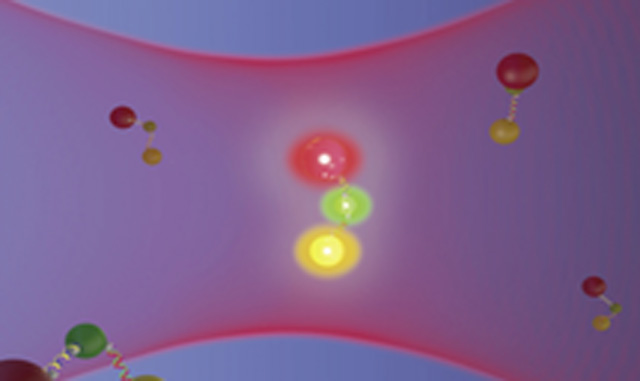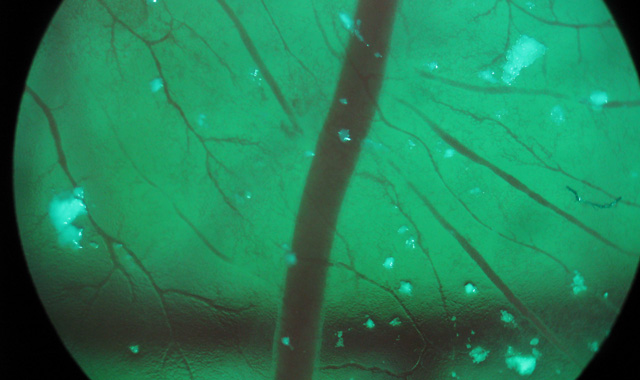Research
At the Cramb Group, we conduct world-class research on the application of nanotechnology to biomedicine. Our findings can be developed for a wide range of applications, including multiple biomolecular binding and membrane dynamics.
We have studied a wide range of biomedically relevant topics, with emphasis on methods of treatment and diagnosis, including cancerous tissue studies with nanoparticles using embryonic models for angiogenesis.
By developing a unique technique and instrumentation scheme, we’re the world’s only group with the ability to directly observe binding of three spectrally distinct entities in real time. Using this scheme, we study complex macromolecule formation and nanoparticle behavior.
Research Techniques
We utilize a wide variety of biophysical and spectroscopic techniques in our research, including:
- Fluorescence correlation and cross-correlation spectroscopy (FCS/FCCS)
- Confocal microscopy
- Dynamic light scattering (DLS)
- Transmission electron microscopy/scanning electron microscopy (TEM/SEM)
- Atomic force microscopy (AFM)
Science in Education
‘Learning-science-by-doing-science’ (LSDS) is an emerging self-guided process-learning model in postsecondary science education. It offers authentic science research opportunities that drive students to think and act like scientists. This study investigates the LSDS approach as a potential model for science learning at the postsecondary level, and aims to answer this main research inquiry: What perceptions do students and teaching staff have of students’ learning gains and the quality of their learning experiences in an authentic research environment within the LSDS model?
Research Interests


Viral Modeling Using Nanotechnology
We are interested in developing lipid nanoparticles into model virus systems. We are currently focused on incorporating viral components from SARS-CoV-2 into nanoparticles to make safe, non-infectious “viral mimetics” for further study of physical chemistry relevant to the mechanism of COVID-19.

Nanoparticle – Serum Protein Interactions
Nanoparticles in biological systems such as the bloodstream are exposed to a complex solution of biomolecules. We use FCCS to directly investigate the complex interactions between blood serum albumin proteins and nanoparticles, focusing especially on the first steps of binding that take place. Understanding these processes at the molecular level is critical for the rational design of nanoparticle surfaces for biomedical applications.

Three-Colour Molecular Binding
Fluorescence cross-correlation spectroscopy (FCCS) is a useful technique for detecting association of different fluorescent species in solution. With increased ability to fluorescently label biomolecules it is now possible to measure interactions critical to specific biological processes. However, many complex biological pathways involve greater than two simultaneous interactions. Our group is working towards the direct measurement of differently colored species using three-color FCCS.

Nanoparticles in Embryonic Models
Nanoparticle toxicology is an increasingly popular and important area of study in adult organisms. However, the effects of nanoparticles on embryos have not been fully studied. Our group works on injecting fluorescent nanoparticles, such as quantum dots, polystyrene fluospheres and lipid nanoparticles, into chicken embryo models. Our goal is to study potential toxicological effects, such as aggregation and uptake into embryonic blood vessel walls and organs.

Nanodelivery of Nucleic Acids
We formulate and study liposomes as delivery vehicles for development and optimization of siRNA therapeutics. Currently our focus is an siRNA therapeutic delivery for treatment of COVID-19.